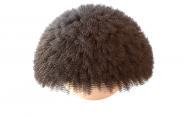Untangling the problem of animating tightly curled hair

Tightly coiled hair, wrinkling in cloth, and how objects collide - these are a few of the things that still give computer animators headaches.
But now, Theodore Kim, associate professor of computer science, and his research team have developed new mathematical techniques that allow for faster, more robust, and more accurate ways to depict these and other natural phenomena. They are described in three papers that Kim and his graduate students, Haomiao Wu and Alvin Shi, will present this week at the ACM SIGGRAPH / Eurographics Symposium on Computer Animation (SCA).

For all the advances that have been made in computer animation in the last few decades, there are still some physical phenomena that are poorly understood and particularly tricky to capture. One of these is creating different types of hair that look and move realistically. Since the early 1990s, progress has been made, but most of the advances have been for the straight or wavy hair that is most common to white characters. At a time when there are calls for animation studios to have wider ethnic and racial representations in their stories, diversifying hair types is critical.
To that end, Kim’s new paper Lifted Curls: A Model for Tightly Coiled Hair Simulation, describes a new physical model that his lab developed for animating tightly curled hair, otherwise known as afro-textured, kinky, or Type 4 hair. This includes how it moves when it is stretched or bent.
“The closest previous work to this is the curly hair system developed for Merida in Brave,” Kim said, referring to the white main character of the 2012 Pixar movie, who has loosely curled hair. “But we are looking at curls that are much tighter than that.” Coincidentally, the technique for Brave was published ten years ago at the same conference where Kim and his colleagues are presenting.
Like much of computer animation, capturing the physics of hair is achieved through a series of sophisticated mathematical equations. Counterintuitively, Kim said, the math for very curly hair can actually be much simpler than that for straight hair. Within the field, it’s long been believed that the cross-sectional twist along a hair needs to be carefully simulated in order to achieve realistic hair motion. This quantity can be tricky to compute, but according to Kim, its effects are much less prevalent in highly coiled hair. By discarding it, his team showed that a much simpler model can be devised.
Before designing the math to describe the physics of the hair, the researchers closely examined actual hair. In this case, they acquired wigs containing curls with a radius of less than 5 millimeters and measured things like the tightness of the curl and the distance between successive curls. They also had extensive discussions with an expert on digital representation of tightly coiled hair, Professor A.M. Darke at the University of California, Santa Cruz. Professor Darke, who is a co-author on the paper, provided detailed insights into what shapes the hair should form and how it should move.
“If you look at the math of previous models, they're kind of tailored for straight hair, so you can get wavy hair like on Moana,” Kim said, referring to the title character of the 2016 Disney film. “But if you put her side-by-side with a photo of somebody with actual afro-textured hair, it's not close at all.”
The researchers subsequently found that some of the math that they had developed for tightly coiled hair could be applied to other phenomena, such as buckling soda cans or objects colliding.
One paper, An Eigenanalysis of Angle-Based Deformation Energies, led by graduate student Haomiao Wu, generalized the hair analysis and applied it to elastic rod and shell simulations. In one demonstration, she simulated a cylinder of chain-link fencing being crushed. Unlike more popular simulation techniques, where the fencing merely contracted unconvincingly, Wu’s results collapsed and buckled realistically.
In the paper A Unified Analysis of Penalty-Based Collision Energies, led by graduate student Alvin Shi, he used some of the hair techniques to analyze how objects collide. In one example, they pulled two bundles of ropes against each other. Using previous techniques, some of the ropes popped non-physically through each other when the tension became too high. Using his new collision analysis, the ropes tensely stretch against each other correctly.
“Usually, the people computing these things just see a sea of numbers, and it was hard to know what’s really was going on,” said Kim, who recently won his second Academy Award for his work in computer animation. “But with our analysis methods, we can start seeing the geometric structure of what's happening. We can gain a much better understanding of what's going on inside all these collisions.”
As is often the case, it can take a while before innovations make their way from academia to industry. Kim said it would be great if their work could find its way to film studios and lead to greater representation in the next wave of animated movies.
“We're hoping it does that,” he said. “But even if they don't use our stuff and come up with their own, I would call it a win. It would be great to see ten different curly hair models out there.”
Funding for this research came in part from the Bungie Foundation and the National Science Foundation.

